FREAK OUT! - FILLMORE WEST, 1966: INTO THE ROCK INDUSTRY
FREAK OUT!
In 1965 Zappa took the lead of a band called "The Soul Agents", which ultimately led to the first album "Freak out!" by
this group, now renamed as "The Mothers of Invention". It got recorded in 1966, preceded by demos recorded the year before.
"Freak out!" can be divided in two sections. The first part, sides 1 and 2 of the original
double album, contains relatively uncomplicated pop songs, at least for Zappa standards. As a debut album it had to reach
for a public after all. The album didn't include a hit single, nor was it a hit by itself. It remained low in the charts
over a longer period though, thus Zappa was able to build up an audience and achieve some cult status.
The second part, sides 3 and 4, is the experimental section, with improvised vocal parts.
With this part Zappa addressed himself to the Los Angeles freak scene, the group of young people in the city,
that stood for an unconventional way of life. Compared to the Cucamonga singles the songs have gained in strength,
but they remain relatively easy compared to the Zappa compositions to come. In 1974, when celebrating the 10th
anniversary of the Mothers of Invention, Zappa put the songs of the album on the menu for a gig at Chicago's
Auditorium Theatre and commented in an interview how easy these songs were compared to what the band had been
doing recently. Nevertheless the album was conceived of as being controversial, maybe also because of the explicit
cynicism of the lyrics.
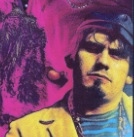 The packaging, a double album with two experimental sides, was definitely unusual in 1966. So were the colour effects
and letter types on the album cover.
Zappa negotiated the album to be sold for the price of a single record, when he in return would decline
the royalties over the second disc. To the left: section from the Freak out! album cover with bass player Roy Estrada.
Roy was a steady member during the sixties and returned working with Zappa in the years 1976-7 (Zoot allures, FZ:OZ
and Baby snakes, the movie).
The packaging, a double album with two experimental sides, was definitely unusual in 1966. So were the colour effects
and letter types on the album cover.
Zappa negotiated the album to be sold for the price of a single record, when he in return would decline
the royalties over the second disc. To the left: section from the Freak out! album cover with bass player Roy Estrada.
Roy was a steady member during the sixties and returned working with Zappa in the years 1976-7 (Zoot allures, FZ:OZ
and Baby snakes, the movie).
1. Hungry freaks, daddy (studio version)
"Freak out!" opens with three rather sharp songs, stylistically as well as regarding the content of the lyrics. The set-up of
the album opener "Hungry freaks, daddy" goes as follows:
First block.
- 0:00 Instrumental opening lick of two bars with a bass riff and a chords progression. This progression is
a parallel movement of three major triads: A-C-D. From the beginning Zappa has approached diatonic music as modal,
where he can swiftly move through a number of scales and mingle closely related scales as it suits him. In this case
the A and C chord are treated as equally important and since they don't belong to the same scale, they cause a modulation.
The opening lick begins in A Mixolydian, next it moves over to C major pentatonic, after which the music returns to A Mixolydian via step IV.
Over the C pedal part both the F/F# and B/Bb are avoided, also during the solo halfway, turning it into a pentatonic use of a major type of scale.
There is a chromatic Gb present in the guitar part, however, as a passing-through note towards A (G-Gb-A).
- 0:14 Theme I with the opening lick continuing ("Mr. America, walk on by ...").
- 0:27 Theme II with a chord progression over an E pedal by the bass ("Mr. America, try to hide ...").
This progression is D-E-Em. So at first another parallel movement of two major triads, followed by a switch to a minor triad.
Again this causes a modulation, this time from E Mixolydian to E minor/Aeolian. The D and E chords fit in as steps VII-I
of E Mixolydian (each for one bar), but the Em chord, played during two bars, can only be interpreted as a modulation.
- 0:34 Theme I again.
- 0:44 A new ending for theme I, with the chord progression C#m-Bm-E-Bm. It's used in case there's a transition to theme III.
- 0:51 Theme III, made up of a couple of phrases ("They won't go(-oh) for no more ...").
a) 0:51 Phrase a with the C#m and Bm chords continuing. The bass pedal plays a little lick with C#-G#-C#-B-F#.
The set of notes remains the same.
b) 0:57 Phrase b as a variant upon phrase a. This one is using the D and C#m chords, with the bass lick being D-A-D-C#-G#.
c) 1:04 Phrase c with the progression Bm-F#m.
d) 1:10 Phrase d with the progression E-D-E-F#m-E, played twice.
The whole period from 0:44 through 1:10 is using the same set of notes, but without an overall key note. It begins on B as if being in B Dorian
and ends on E as if being in E Mixolydian.
Second block.
- 1:17 This is a repetition of all of the chords and bass lines of block 1 as an instrumental interlude with a guitar solo.
It's very common to play an interlude or a bridge in this manner in pop-music, but Zappa seldom recorded guitar solos in that manner. See the Shut up 'n
play yer guitar and Guitar sections for his standards for playing guitar solos.
During the Freak out! recording sessions the band got supplemented by session musicians,
including cellos and brass, making it difficult to identify who's playing which part. The mothers themselves get credited for their regular
instruments.
Hungry freaks, daddy, 1:28-1:37 (midi file).
Hungry freaks, daddy, 1:28-1:37 (transcription).
I've transcribed the example above by combining the basic tracks and complete
versions from "MOFO" and "Freak out!" (see below for "MOFO"). This way you can hear three guitar parts. Both Zappa and Elliot Ingber are credited for playing lead
and rhythm guitar, so also here I can't tell who's playing what. The example starts with the last repetition of the lick of theme I and continues with the four
bars that form theme II.
Third block.
- 2:20 Second repetition of block 1, this time with the lyrics returning without changes.
- 3:21 The last note from theme III being held with a few solo notes as the song's ending, added during the second take. On the basic tracks
from "MOFO", the band fades out at 3:21.
- 3:27 End.
Continued below with a 1966 live version of this song.
2. I ain't got no heart (1966)
This second note example is part of "I ain't got no heart", the second song on "Freak out". The harmony for the
first theme is the progression I-II-III-II in G Dorian. For the second theme it goes as IV from G Dorian (with an extra A as a
passing-through note), moving through V of G to IV of B Dorian.
I ain't got no heart, theme (midi file).
I ain't got no heart, theme (transcription).
As pop music chords these last three chords it can be identified far more easily, namely as a C-D-E progression. Thus a sequence of three major triads.
Than it goes back again to G Dorian. The sung melody isn't difficult, but the instrumental passages as in bar 4 and 8
add flavour to the song. The lyrics include "I sit and laugh at fools in love, there ain't no such thing as love, no
angels singing high above today". The 1965 demo version of this song started with an instrumental intro, skipped on "Freak out!". See the previous
section for a couple of bars from this intro. In 1981 a live version got included on "Tinsel town rebellion".
3. Who are the brain police?
 "Who are the brain police?" has a gentle main theme, but gets
interrupted by an ugly noisy interlude, stressing the hostility of its lyrics. Perhaps this is Zappa's most direct effort at social criticism.
In 1970 "Who are the brain police?" returned on the setlist, but with entirely newly written music (see the Fillmore East 1970 and
Carnegie hall sections for examples). The lyrics were kept the same.
"Who are the brain police?" has a gentle main theme, but gets
interrupted by an ugly noisy interlude, stressing the hostility of its lyrics. Perhaps this is Zappa's most direct effort at social criticism.
In 1970 "Who are the brain police?" returned on the setlist, but with entirely newly written music (see the Fillmore East 1970 and
Carnegie hall sections for examples). The lyrics were kept the same.
Who are the brain police?, 0:49-1:24 (midi file).
Who are the brain police?, 0:49-1:24 (transcription).
Nominally "Who are the brain police?" is in G. It's a recurring feature in Zappa's music that he can play chord types parallel. The first two tracks from
above also show this. In this case it's a major triad again:
- bars 10-12 and 16-18: bass pedal G plus D as chord (or Gmaj9 for the total).
- bars 13-15: bass pedal A plus E as chord.
- bars 19-21: bass pedal F plus C as chord.
By doing so you're soon getting at notes getting altered, like the G becoming sharp during bars 13-15. One could call that an incidentally altered
note, still interpreting it as step II plus V from G major. Since both the bass figures and the chord are getting transposed, there's also a valid
argument to call these chord changes key changes. Thus a sequence of G major, A major, G major and F major. The G also appears as sharp in bar 3 of the first half
of the main theme. During bars 1-9 Zappa maintains the bass pedal G as natural, causing a dissonance in bar 3. Bar 22 is the first bar of the intermezzo with people
screaming, feedback guitar notes and innuendo-like voices saying "I think you're going to die". It's not really fit for transcribing or to put in a midi file.
Other instances of parallel chords in this study are for example "The idiot bastard son" (YCDTOSA vol. II section, parallel sus2 chords) and
"Son of Suzy Creamcheese" (next section, minor chords). Image above to the right:
The Mothers playing at the Whisky a go-go.
4. Go cry on somebody else's shoulder
After tracks 1-3 the album becomes more friendlier. "Go cry on somebody else's shoulder" is a conventional love song.
On page 169 of his study (see the literature list), W. Ludwig describes this song as a doo-wop parody: "At the start
people are reciting introductory words over a four-bar cadence, I-VI-IV-V. The singing, following upon it, involves
five voices. Two tenors are singing the lyrics, accompanied by one bass (Frank Zappa) and two falsettos.
These two falsetto voices are only singing vocals in a more and more exaggerated way, parodying the doo-wop singing of vocal harmony groups."
Ludwig doesn't mention the key of this opening: it's in G.
Go cry on somebody else's shoulder, 1:25-1:46 (midi file).
Go cry on somebody else's shoulder, 1:25-1:46 (transcription).
This example from the middle of this song contains the following:
- Bars 1-4: second half of theme B with the progression C-Cm-A-D. These chords don't have scales in common. The implied keys are:
Bar 1: C Mixolydian.
Bar 2: C Dorian.
Bar 3: A Mixolydian.
Bar 4: D Mixolydian.
- Bars 5-6: restart of theme A, the main theme. This theme is stable in G, as the intro is.
All of "Freak out!" appears to have been newly written for the Mothers when they started in 1965. No material from the Cucamonga period has been
included. Stylistically only "Go cry on somebody else's shoulder" could be called a continuation upon earlier songs as "Memories of El Monte"
and "Everytime I see you".
5. Motherly love
The CD booklet contains little descriptions of each track by Zappa himself.
"Motherly love" is making
fun of motherly care in a harmless way that can only make you laugh. See the previous section for examples from the 1965 demo recording
and the final version from "Freak out!".
The scores of most tracks from "Freak out!" have at some time been available to the public and copies still must be lying in the closets of the ZFT archives.
During the first decade of this century, the ZFT used the company name Barfko Swill for - among others - selling scores.
There used to be a Freak out collection in their catalogue, including the following titles:
- Hungry freaks, daddy.
- I ain't got no heart.
- Who are the brain police?
- Go cry on somebody else's shoulder.
- Motherly love.
- Wowie zowie.
- Any way the wind blows.
- I'm not satisfied.
- You're probably wondering why I'm here.
During recent years this collection is not shown anymore individually in their site, but one could try to contact the ZFT for getting a copy.
6. How could I be such a fool (1966)
In 1973 Zappa had a "Frank Zappa Songbook Vol. I" published. It covers the years 1966-69 and is an excellent source for this period.
"How could I be such a fool" is present in a piano arrangement with guitar tabs added to it (pages 45-51), next to "I'm not satisfied" (pages 75-81).
The first song starts gently in C, but soon continues modulating. It's made up of three themes.
Theme one is constructed
as a little sequence with the bass line descending, of which I'm including the opening bars as a sample. The meter of this song is 3/4 all through.
How could I be such a fool, bars 5-12 (score).
Very briefly the thematic construction goes as:
- Bars 1-4: instrumental intro with the C-chord.
- Bars 5-20: theme 1 (When I won your love ...).
Theme one knows four phrases of four bars. In the example above you can see that phrase two
is basically a transposition of phrase one, going a major second downwards from C major to Bb major. This happens
again for phrase three. Phrase four has a chord progression of its own. At this point there is no entire scale being used,
but this is the case during the repetition of theme one (an additional F for phrase one and an Eb for phrase two).
- Bars 21-36: theme 2 (I know now that you never ever really loved me ...).
- Bars 37-56: theme 3, the main theme/chorus (How could I be such a fool ...).
- Bars 57-72: theme 1 (There will come a time ...).
- Bars 73-77: the opening bars from theme 3 are now used to form a coda, ending in E Dorian.
The main theme from "How could I be such a fool (1968)" gets dealt with in detail in the
Cruising with Ruben and the Jets section from this study, where it gets compared with the doo-wop version on the latter album.
7. Wowie Zowie
"Wowie Zowie" is the easiest song on the album, about which Zappa is saying: "[it] is carefully designed to suck the 12 year old
listener in our camp [...]. It is cheerful. It is harmless." The song's title, "Wowie Zowie", appears to have been a favorite line
by Pamela Zarubica. Pamela worked as a secretary at the Whiskey a go-go and shared a house with Frank for a while, before he met Gail.
She belonged to the inner circle of the Mothers, the first on the list of contributors from the album's inner sleeve.
The song ends with referring to the The four seasons' hit "Sherry".
Wowie Zowie, 1:18-1:39 (midi file).
Wowie Zowie, 1:18-1:39 (transcription).
The set-up of "Wowie Zowie" goes as:
- 0:00 Instrumental intro.
- 0:09 Theme A, motif 1, instrumentally. It's a figure of two bars in C, that are getting repeated.
- 0:17 Theme A, motif 1, continues with lyrics.
- 0:27 Theme A, motif 2.
- 0:31 Theme A, motif 3: part of the intro is now used to round off theme A.
- 0:37 Theme A returns.
- 1:02 Theme B.
- 1:18 The example from above begins.
Bars 1-4 are a variation upon the opening of theme B, getting built up in layers. It gets followed by motif 1 of theme A, instrumentally.
Next the instrumental intro returns, ending in a different manner. The example stops at 1:39.
- 1:43 Theme B returns, beginning slightly different.
- 2:02 Theme A returns once more.
- 2:28 Outro.
- 2:53 End.
8. You didn't try to call me
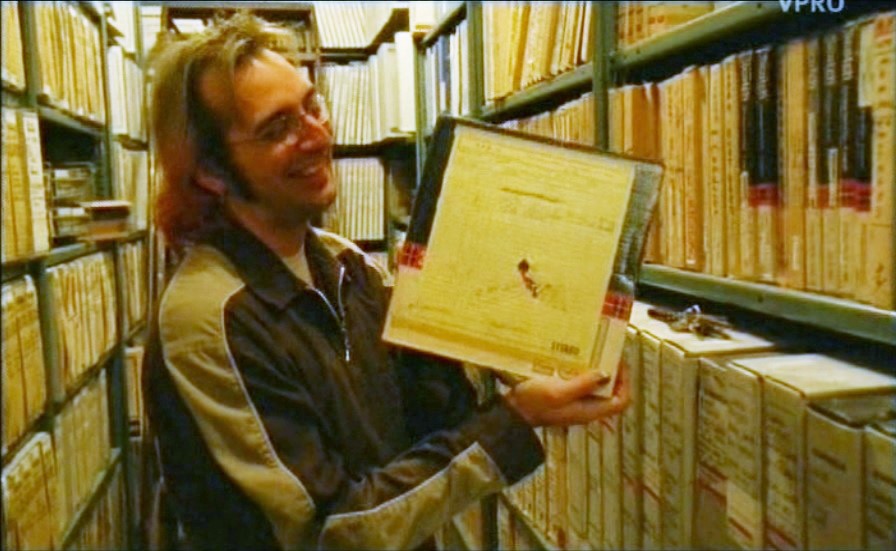 Later in his career Zappa would take a stand against love songs. "How could I be such a fool" and "You didn't try to call me" can be called classical broken hearts
songs of an excellent quality. Though such songs don't abound in Zappa's catalogue, they return every once in a while.
"You didn't try to call me" got recorded again for the doo-wop
collection of the later "Cruising with Ruben and the Jets" album, where I've included three examples from this song in the versions from 1966, 1968
and 1976. To the right: Joe Travers holding the original Freak out! album reel as preserved in The vault (situation in 2000,
documentary by Frank Scheffer, VPRO television).
Later in his career Zappa would take a stand against love songs. "How could I be such a fool" and "You didn't try to call me" can be called classical broken hearts
songs of an excellent quality. Though such songs don't abound in Zappa's catalogue, they return every once in a while.
"You didn't try to call me" got recorded again for the doo-wop
collection of the later "Cruising with Ruben and the Jets" album, where I've included three examples from this song in the versions from 1966, 1968
and 1976. To the right: Joe Travers holding the original Freak out! album reel as preserved in The vault (situation in 2000,
documentary by Frank Scheffer, VPRO television).
9. Any way the wind blows
Zappa recorded "Any way the wind blows" first in 1963. The opening of this specific version is included in the Paul Buff section. It's another song from "Freak out!" that would return on "Cruising with Ruben and the Jets" in a doo-wop setting. On that album this title gets spelled as "Anyway the wind blows". The corresponding section contains the end of that particular track with doo-wop harmonies. The lyrics are referring to the ending of his first marriage, about which he writes in the biographical trivia from the album notes: "Got married when I was 20 ... a lovely girl: almost ruined her life, filed for divorce, moved into my recording studio [etc.]."
10. I'm not satisfied (1966)
As mentioned above, the score of "I'm not satisfied" got published in the Frank Zappa songbook vol. I.
At the end of this songbook, Ian Underwood gets credited for doing the piano arrangements (except for "Little house").
Zappa himself had probably notated a song as "I'm not satisfied" by its lead melody with the chords indicated by their symbols.
See for instance the "Toad of the short forest" example in this study.
Ian combined this with how the band played these pieces when he was in the band, as well as filling it in specifically
for a piano. None of these scores and arrangements are literally played like that on Zappa's albums. The reasons
are that Zappa always could change things on the spot and the element of improvisation. So you've got version differences
all the time.
Below is a literal reproduction of bars 1-12 as how they are played on "Freak out!", next to bars 5-11 from the Songbook.
I'm not satisfied, opening bars (midi file).
I'm not satisfied, opening bars (transcription/score).
As you can see, the songbook version is a piano arrangement with guitar tabs. The execution on "Freak out!"
has the same basis, but on a detail level there are many differences. Just to mention some:
- bar 4: the guitar improvises some notes along the indicated chord.
- bars 9-10: the sung melody goes a bit differently and this melody is performed by two vocalists, using
different notes.
- bar 9: the guitar plays a Dsus2 chord instead of D (as a triad).
- bars 10-12: in the background you can hear a keyboard playing improvised notes in a high register.
The song begins with a little instrumental intro in E Mixolydian
with the chord progression C#m7-D-E. Next you've got the first theme, made up of two phrases. The first, with "got no place
to go", is in D. The second phrase modulates to A Dorian. Only the first two bars, with "I'm tired of walking up and down ...",
are included above. In total it's a phrase of four bars.
A different version can be heard on "Cruising with Ruben and the Jets". On this album, with its deliberate
simplicity, this second phrase got skipped. In the Songbook the whole piece gets notated as in E Mixolydian. In my
study I'm always following the modulations in my notation (the preset sharps and flats). This is a matter of choice.
The general structure of the entire song goes as:
- 0:00 Intro.
- 0:15 Theme 1. See above.
- 0:26 Theme 1 gets repeated.
- 0:36 Theme 2 ("Why should I pretend ...") with an F#m-E chord alternation in F# minor.
- 0:51 Theme 3/chorus ("I'm not satisfied ...") in B Dorian. It has a phrase that gets repeated three times.
The end, with "Life has been abusing me", is a variation upon this phrase in D Dorian.
- 1:05 The intro returns. This time you can hear more instruments being involved. While the example
from above is mostly the Mothers as a five member band, this time you can hear people from "Mothers'
auxiliary" playing. The recording budget allowed Zappa to use a number of session players.
- 1:19 Themes 1-3 return with more session players contributing.
- 2:10 The intro once more.
- 2:17 Instrumental variation upon theme 3.
- 2:38 End.
In 1968 Zappa returned to recording "I'm not satisfied (1968)"
anew for his "Cruising with Ruben and the Jets" album. The lyrics where kept the same, but much of the music was newly composed in a
different doo-wop set-up.
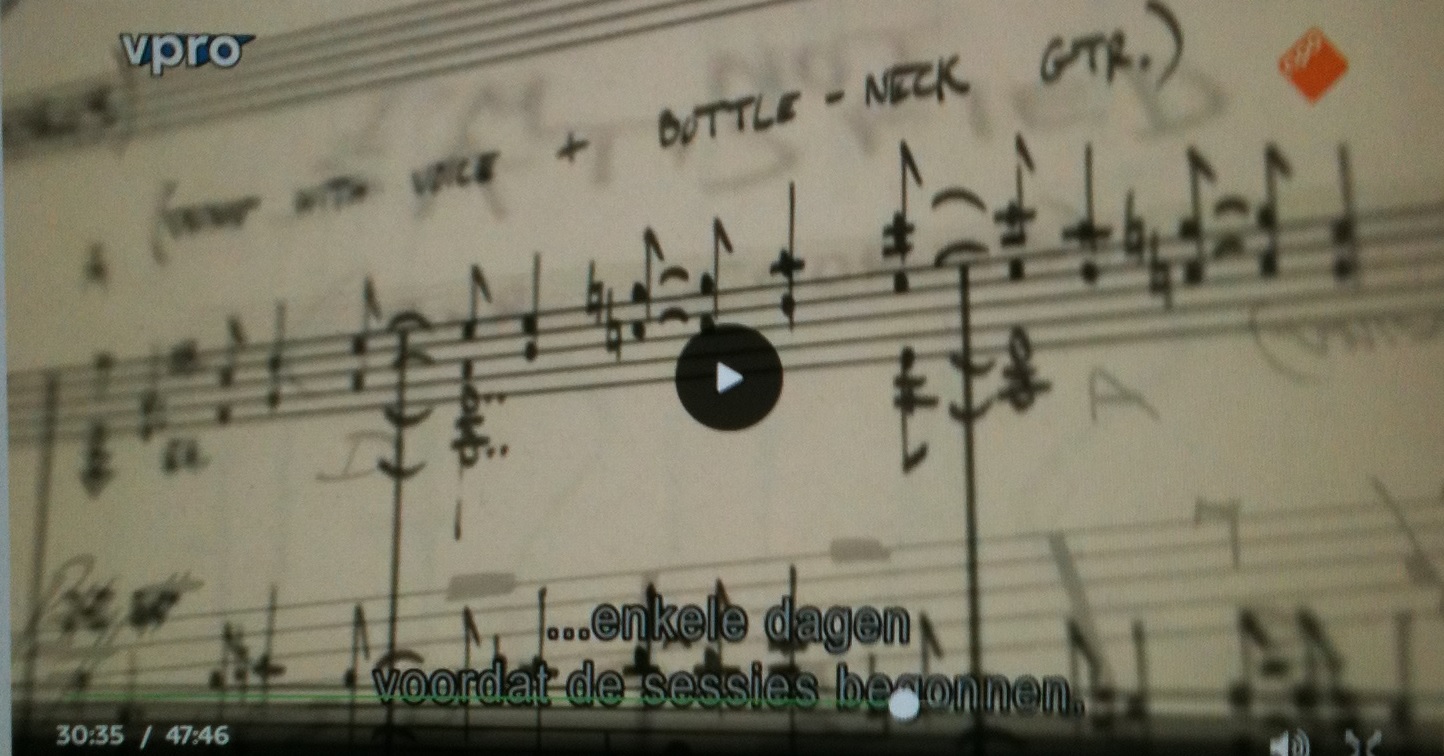
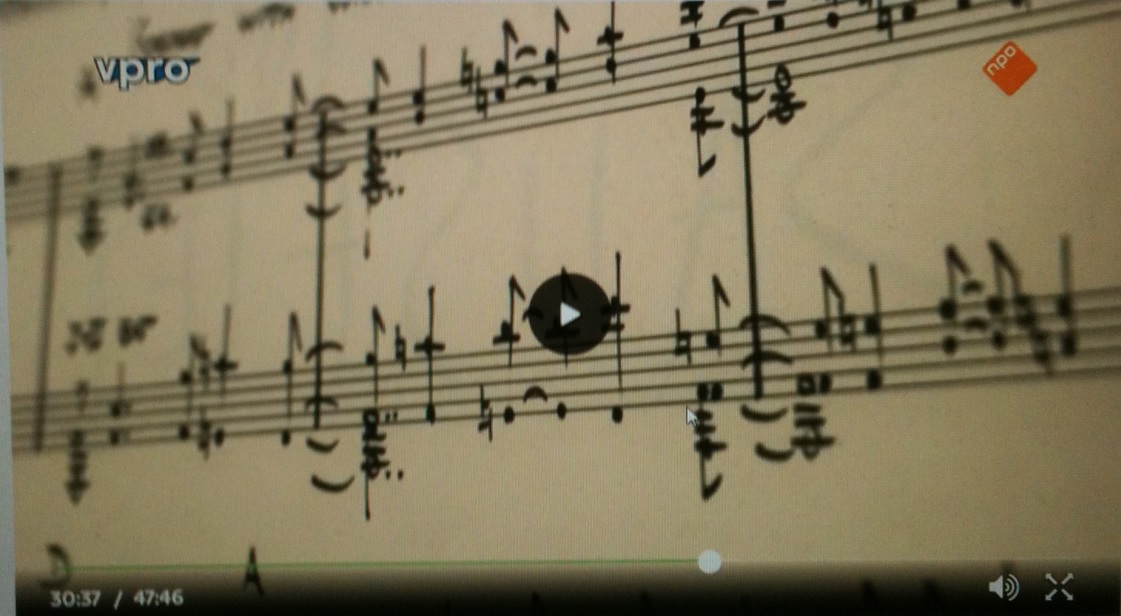

The first two screenshots are from the Classic Albums series concerning "Freak out!", showing that Zappa scored out his music when it served a purpose.
In case of "Freak out!" the album involved session musicians, who Zappa could conduct using these scores. Other fragments of this score can be seen in the background of the MOFO booklets
(third sample). See below for MOFO.

I'm not satisfied score sample (midi file).
It's upper two staves then sound as an unused variation upon phrase two of the first theme from "I'm not satisfied".
Harmonically it sounds interesting. Notated in A and played over an A pedal, these bars blend notes from A (major) and A Dorian.
11. You're probably wondering why I'm here
"You're probably wondering why I'm here" is an early example of a song where Zappa demonstrates his capacity of writing
long melodies, which he would later on do more often in for instance "Florentine Pogen". The whole melody lasts a
minute with only some of the bars repeated.
You're probably wondering why I'm here (midi file).
You're probably wondering why I'm here (transcription).
The melody is made up of several sections; you might also call it a multi-theme song with various shorter
melodies. In the transcription the sections go as:
- Bars 1-4: The song starts in G. The harmonies form a series of regular 5th chords, I-IV-I-VII-VI-V.
Rhythmically most of the piece is in plain on beat 4/4, which is for pop music normal,
but for Zappa standards it's unusually static to do so over a longer period.
- Bars 5-11: Instrumental interlude with a funny quack sound. A gimmick in Zappa's music that would keep returning,
just as the snorks. Bar 11 contains deviant harmonies.
- Bars 12-19: Phrase of two bars in E Mixolydian. Unlike the previous bars, this phrase gets repeated a couple of times.
- Bars 20-21: Section with a chromatic movement. The 6/4 bar causes a short break before a new melody sets in in bar 23.
- Bar 23 till the end of the theme. A larger closing melody, of which only the first two bars are included in the transcription.
12. Trouble every day (1966)
"Trouble every day" was written in 1965 as a reaction upon the Watts riots in L.A.
Here it's played over a bass and guitar vamp in E Dorian. The bass vamp lasts one bar, while the guitar riff lasts two bars.
A harmonica is improvising along with it. Bars 9-12 constitute a side theme, that returns every now and then to break the pattern
of the returning vamp. Harmonically the bass
follows a I-IV-V progression here (I for the vamp and IV-V for the side theme).
Trouble every day, section (midi file).
Trouble every day, section (transcription).
Zappa is here singing in a manner that much later would become known as rap.
He would return to this song in 1974 in a very different version on
"Roxy and elsewhere", in the shape of "More trouble every day". The lyrics got re-used, but the music is newly composed.
"Trouble every day", as you can find it on the "Does humor belong in music?" CD from 1984, is also following the new 1974 version.
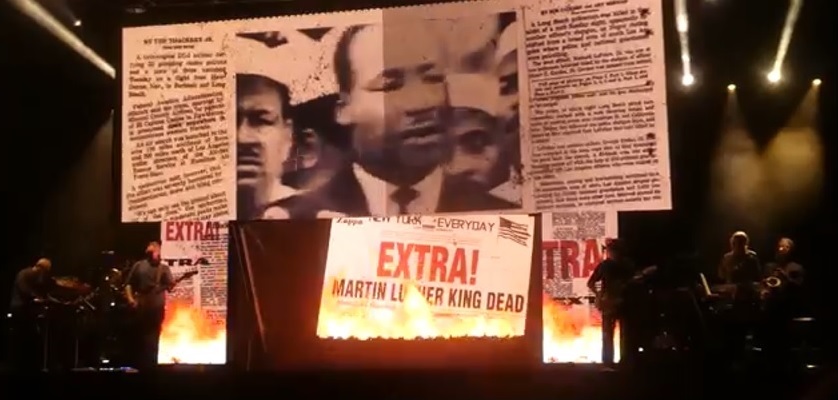
Screenshot from the 2019 The bizarre world of the Frank Zappa tour. Next to Zappa as a hologram there was an ongoing video
presentation. When the band played "Trouble every day" various newspaper articles were shown on video screens, not only about the
Watts riots, but also related subjects as racial tensions. The lyrics from this song include lines like "I'm not black,
but sometimes I'd wish I wasn't white."
13. Help, I'm a rock
"Trouble every day" is followed by the experimental part of "Freak out!". "Help, I'm a rock" is built around various riffs and drum patterns.
On the vinyl album it appears to have had two movements with a separation between them.
Help, I'm a rock, opening (midi file).
Help, I'm a rock, opening (transcription).
The example above opens with its main "Help, I'm a rock" motif, whereupon in bar 17 it is followed by improvised lyrics with
fantasy texts. It's in 3/4 using the uncommon Phrygian scale. This scale begins with a minor second, in this case
the A-Bb movement by the bass.
14. It can't happen here
The largely vocals only song
"It can't happen here" has a written lead sheet, along which the other singers improvise.
Between 1:09 and 1:54 there's an atonal instrumental jazz type of improvisation section.
This lead sheet for "It can't happen here" used to be in the Barfko Swill catalogue, like the Freak out! collection
not listed anymore (see the published scores page from the CDs and scores section for an overview how it once used to be avialable).
Below are two fragments from this piece. The first are bars 1-5 from the opening. Here it's all a capella.
Zappa sings the lead melody from staff 1. Harmony notes are supplied by 4 to 5 other vocalists. It's atonal with maybe some fragments
with diatonic material. On the two "here" notes sustained dissonant chords are formed. The second example is a small outtake from
the drums-piano part, being outspoken atonal. The set-up, a drummer ticking steady 16th notes on a cymbal, and a pianist improvising,
is remindful of a jazz combo.
It can't happen here, 0:00-0:06 (midi file).
It can't happen here, 1:30-1:36 (midi file).
It can't happen here, sections (transcription).
Tracks 13 and 14 are sometimes presented as one track, with "It can't happen here" being
a second movement for "Help, I'm a rock". Though they sound as a one-time only experiment, Zappa performed both
tracks live as well. His son Dweezil included "It can't happen here" in the setlist of his 2018 Zappa plays Zappa tour.
15. The return of the son of the monster magnet
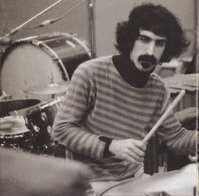 For "The return of the son of the monster magnet" Zappa invited some 50 people from the L.A.
freak scene to come to sing and play along with the Mothers for an evening session in the studio. He edited some 12
minutes from the event, whereas the ZFT released some more sections on "MOFO" 40 years later.
For "The return of the son of the monster magnet" Zappa invited some 50 people from the L.A.
freak scene to come to sing and play along with the Mothers for an evening session in the studio. He edited some 12
minutes from the event, whereas the ZFT released some more sections on "MOFO" 40 years later.
The return of the son of the monster magnet, opening bars (transcription).
Like "Help, I'm a rock" this piece is also built around a number of riffs and drum patterns.
It opens shortly without a meter
with only a siren and somebody shouting. Next Jimmy Carl Black joins in and sets the meter to 4/8.
Image to the right: Zappa at the percussion set during the Freak out recording sessions (sample from the MOFO booklet).
The album liner notes state that "Monster magnet" is made up of two movements. The original vinyl album seems to have
had a separation between them to distinguish the tracks. In the Ludwig study the piece gets described in the table below.
It's in German, but with translating devices on internet at hand, this is not a real problem anymore.
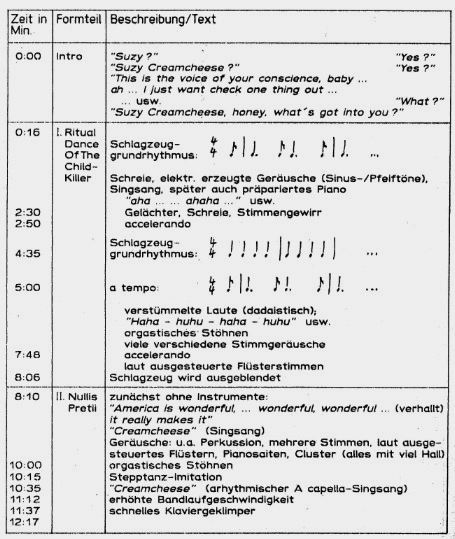
Pamela Zarubica and Jeannie Vasser alternatively played the role of Suzie Creamcheese. Jeannie is briefly audible
at the beginning of this track. Pamela wrote the little message on the album sleeve. My example from above is the start
of movement I (Ludwig groups two of my 4/8 bars into 4/4). The second movement starts at 8:10, called "Nullis pretii",
Latin for "of no value" (referring to Zappa's "no commercial potential" line). It's the part that begins with people
saying "America is wonderful".
FILLMORE WEST, 1966 - MOFO
"Freak out!" is produced in a manner that today sounds typical of the sixties. It's influenced by the then popular "wall of sound" effects, that Phil Spector introduced, and the only Zappa recording that has this. The demos don't, nor the follow-up albums. It's both its charm and a flaw of the album. The instruments, most specifically the rhythm guitar, have some sort of hollow echo, that for today standards sounds old-fashioned. There are extra brass instruments playing along with the rock band. Thirdly the stereo has a strong left-right division, common when stereo got introduced for rock music. Later on this division would be made less sharp, as a band plays in front of you rather than at your sides. Officially the album is produced by Tom Wilson, which was contractually agreed upon. He delegated most of the actual work to Zappa. For his CD remix Zappa mixed the rhythm guitar a bit down. In 2006 the ZFT re-released the original mix on "MOFO", to the acclaim of the fans, thus the original mix was popular. The remainder of "MOFO" is mostly tracks split into basic and overdub recordings. This is of some interest if you want to know how the band recorded its songs at that moment and if you want to hear all the details as clearly as possible. Otherwise it's something to raise your shoulders about.
The downtown talent scout
Historically the handful of live recordings on the 4-CD version of "MOFO" is
of interest. They stem from a Fillmore West concert, 1966, from which Zappa himself released "The downtown talent scout" on
YCDTOSA Vol. V, as well as "Plastic people" on "The mystery disc". It's the first more serious live recording that gives some idea
how a Mothers concert would have been like in the early days. The other 1965-6 live tracks are individual songs, often with
inferior sound quality. In this case the Mothers were the opening act for a Lenny Bruce concert. Zappa calls the hall Fillmore West. More
accurately would be Fillmore Auditorium, the official name it had in 1966. The location became renamed as Fillmore West in 1969, to distinguish
it from the just opened Fillmore East. By then it had moved as well (Ronald Light wrote me about this). Spread out over three different
releases, you can find:
- YCDTOSA: "The downtown talent scout".
- The mystery disc: "Band introductions from the Fillmore West".
- The mystery disc: "Plastic people" (Richard Berry version).
- MOFO (4 CD): "Motherly love".
- MOFO (4 CD): "You didn't try to call me".
- MOFO (4 CD): "I'm not satisfied".
- MOFO (4 CD): "Hungry freaks, daddy".
- MOFO (4 CD): "Go cry on somebody else's shoulder".
The downtown talent scout, opening (midi file).
The downtown talent scout, opening (transcription).
Just as the demos on "Joe's corsage", these live versions don't differ much from the album versions. "The downtown talent scout"
is a unique song in this group, not released elsewhere as well. It's an early easy going example of Zappa speech-wise
singing over a vamp. This vamp is in A Dorian (bass pedal note) over which the chord alternation III-IV is played. It's
a simple progression compared to later pieces as "Central scrutinizer". Zappa's singing follows the 4/4 meter here quite
clearly, while in later songs he would often let the rhythm of the spoken language prevail. The lyrics stand central in this
song and give a nice picture of the government spying on the L.A. freak scene. Ray Collins gets credited for playing
tambourine, but actually plays harmonica.
Hungry freaks, daddy (live version)
For a 1966 live recording, the sound quality is reasonable. Next is the opening and a part of the solo from "Hungry freaks, daddy" as
played at the Fillmore West. Two guitars start with playing the opening riff. The bass is either not playing here, or it has become
inaudible on the tape.
Hungry freaks, daddy (Fillmore West), 0:00-0:24 (midi file).
Hungry freaks, daddy (Fillmore West), 0:00-0:24 (transcription).
In bar 5 the lyrics start. The notes from staff one are melodic, the ones from staff two are a constant E, following the rhythm.
It all sounds as if in A Dorian till you get at bar 7, where the chord upon the A from beat one is played as a major triad. So, like above, the chords
can belong to A Mixolydian too.
Hungry freaks, daddy (Fillmore West), 1:05-1:30 (midi file, tempo change not included).
Hungry freaks, daddy (Fillmore West), 1:05-1:30 (transcription).
This second example begins with the last bar from the sung section. In the next bar you can hear guitars doing what a kazoo is doing in the studio version.
This gets followed by the guitar solo, which is the more specific part of this live version. You can compare it with the example from above from the studio version.
Like during the opening I don't manage to hear what the bass is doing. It might be that some notes from the second staff are actually bass guitar notes, others guitar notes
by the accompanying guitar.
Groupie bang bang
"Groupie bang bang" is a studio recording from 1966 that remained unused in Zappa's own catalogue. It premiered on 4-CD deluxe version of "MOFO" only.
It gets mentioned in the "Must record" list of which you can find a photo in the MOFO booklet. The example below contains:
- Bars 1-3: instrumental intro. The song is in C.
- Bars 4-7: theme 1, which keeps alternating with the next theme 2.
- Bars 8-11: start of theme 2.
Theme two is drawing upon "Not fade away" by Charles Hardin (better known as Buddy Holly) and Norman Petty, covered by The Rolling Stones in 1964.
On his turn Buddy Holly is re-using a rhythm that has become known as the Bo Diddley beat, who himself is continuing upon traditional material.
Groupie bang bang, 0:22-0:44 (midi file).
Groupie bang bang, 0:22-0:44 (transcription).
In the transcription I've also included the drum part, without much details, for its contribution to the rhythmic feel of the song.
The term groupie came into being around 1965, standing for female fans who started following pop artists and bands hoping to become part of their inner circle
and start relationships with them. They became the subject of many songs on Zappa's 1970-1 albums.
